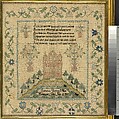Sampler
Catherine Cassady American
Not on view
Dated February 14, 1814, Catherine Cassady’s Washington, D.C. sampler was completed six months before the United States capital was attacked by the British during the War of 1812. Not only did British troops set fire to the U.S. Capital and the President’s Mansion, they also burned parts of the Washington Navy Yard, which was in the neighborhood where Catherine lived, in the southeastern part of the city. Catherine’s sampler came to The Met as one of a pair of similarly designed samplers. The other is dated twelve years later and was made by Margaret A. Cassedy (MMA 2007.78).
Catherine and Margaret’s samplers are part of a group of thirteen known "Navy Yard" architectural samplers, dating from 1810 to 1842. These samplers share a similar layout, with a verse at the top flanked by floral motifs, a centrally positioned brick structure on a grassy lawn, and a serpentine floral boarder. A distinctive characteristic of Catherine’s and Margaret’s samplers is the design of central brick structure -- a three-towered building with a cross on each tower at the top of a stepped hill with grazing sheep. The building is a variant of the traditional needlework rendition of the Gates of Jerusalem, found on eighteenth century German samplers and on early nineteenth century Philadelphia and Delaware Valley samplers, a design likely taught by a teacher of German descent. To either side of the stepped lawn of these samplers there are four identical courting couples standing under identical triangular pine trees. The symmetrical placement and stylized rendering of the terraced lawn, trees and figures, results in an overall spare, geometric design.
While Catherine’s design appears to have inspired Margaret, each girl selected a different verse to stitch in black silk thread above the red brick building. Catherine’s verse, flanked by vases of flowers, is a religious message attributed to the Rev. John Newton of London, written about 1750. Margaret’s verse, flanked by hearts and flowers, extolls health, peace and competence and is from "Epistle IV" of Alexander Pope’s Essay on Man (1734). Both verses often appear on British and American samplers during the opening decades of the nineteenth century. While Catherine signed and dated her sampler with the earlier name "Washington City" Margaret’s later sampler uses "Washington D.C."
Catherine was the daughter of Irish immigrants, Margaret (1778-1846) and Nicholas Cassady (d. 1832). Her father was a shoemaker with a business in the Navy Yard Hill area sufficiently large enough to support several apprentices. She never married and died on February 19, 1827. An announcement of her death in the National Intelligencer two days later, reads: Cath. Cassedy [sic], died in her 24th year, eldest daughter of Nicholas Cassedy [sic], funeral at father’s residence opposite the Marine Garrison today."
The exact relationship between Catherine Cassady and Margaret A. Cassedy is puzzling. Although their samplers are of the same design and descended together in the same family, Catherine and Margaret spelled their last names differently and a record of Margaret’s birth and death dates remains unknown at this time.
Due to rights restrictions, this image cannot be enlarged, viewed at full screen, or downloaded.

